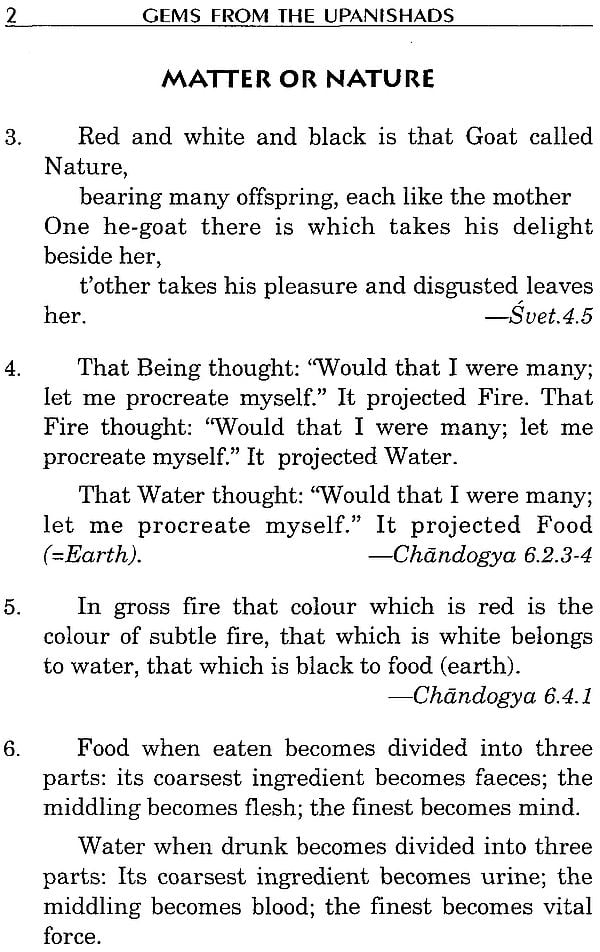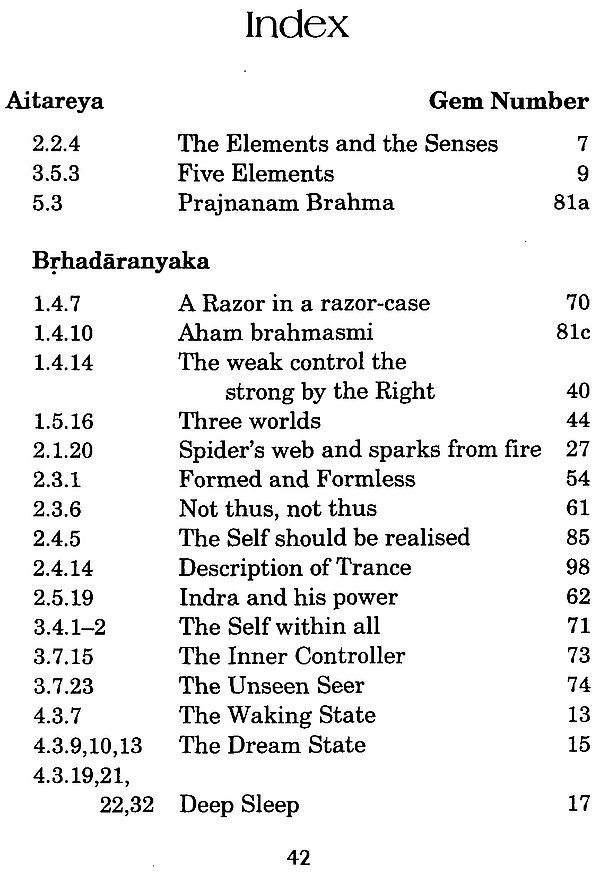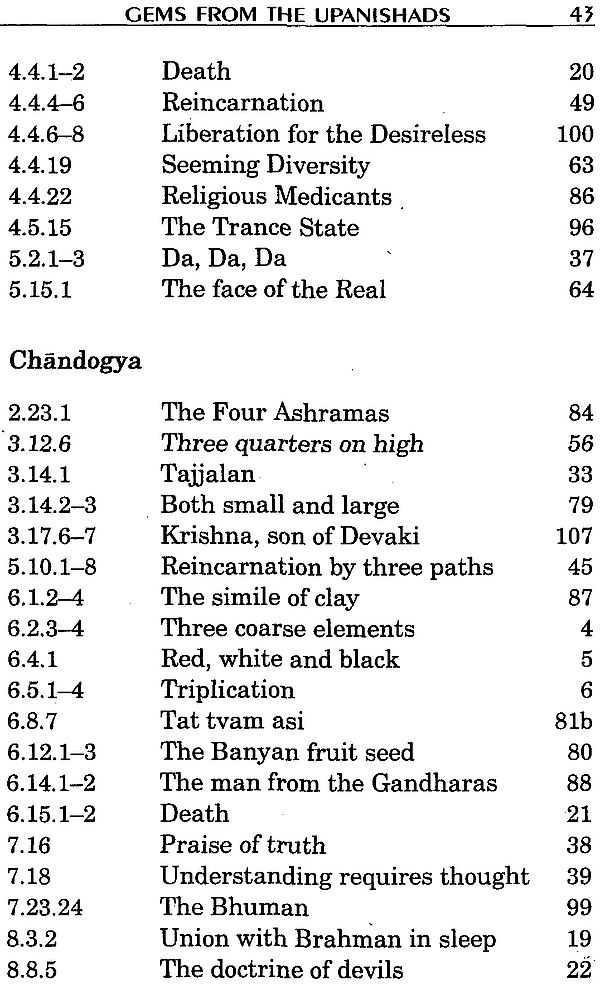
Gems From The Upanishads
Book Specification
| Item Code: | NAB522 |
| Author: | H.B. Phillips |
| Publisher: | Sri Ramakrishna Math Printing Press |
| Language: | English |
| Edition: | 1977 |
| ISBN: | 9788171209354 |
| Pages: | 42 |
| Cover: | Paperback |
| Other Details | 6.7" x 4.7" |
| Weight | 50 gm |
Book Description
From the Preface
We have great pleasure in presenting to our readers this pretty "Garland of Gems from the Upanisads".
Aptly have the Upanisads been named the Himalayas of the Soul. Purusat na param kincit: There is no limit to the heights to which the human spirit can soar. And the Upanisads are the expressions of some of the finest moments of the experiences of our ancient sages in their contemplation of the Divine. We do not know how many millennia have passed since those inspired talks were recorded in our forest universities. But age has not withered nor custom staled their unfading freshness and charm. It must however be borne in mind that these utterance form not so much a logical approach to Reality as a poetic apprehension of it. Hence we can find in them philosophic concepts at different levels. As Sri Ramakrishna has observed from the profundity of his own experience, the aspirant has to choose from them what suits best his particular mental and emotional make up.
Prof. H. B. Phillips who has, as a labour of love selected 108 gems from the Upanisadic mine and strung them into a fascinating array, is a Sanskrit scholar from S. Africa. He is intensely interested in Indian scriptures and holds the certificate of Vedacarya. We are grateful to him not only for compiling this brief anthology but also for partly subsidizing its publication.
THE word Upanisad, whatever its original meaning, soon came to signify "secret or esoteric doctrine," as in Svetasvatara 5.6: "That which is hidden in the secret of the Vedas, even the Mystic Doctrines (Upanisad)" (Hume). As the earliest Upanisads generally came at the end of the Brahmanas and or Aranyakas, themselves a late stage in Vedic literature, they are also referred to as Vedanta or "end of the Veda". The great commentator, Sankara, wrote commentaries on most of these, together with a few others, eleven in all, and these are the ones chosen for selection in this work. Altogether there are over 200 so called Upanisads, although the traditional number is fixed at 108. Some of these teach Vedanta, but most are more concerned with Yoga, Sannyasa, or glorifying Visnu, Siva, Sakti, etc., and so can make no serious claim to belong to the Vedic cycle. To date the early Upanisads is difficult, even to arrange them in sequence, but it is generally agreed, I think, that the longer prose Upanisads belong to 8th and 7th centuries B.C. and are pre-Buddhistic. Some of the later of these ''Vedic'' Upanisads, like Svetasvatara refer to Yoga and perhaps Siva.
In his History of Sanskrit Literature, A.A. Macdonell claims that the Upanisads represent a new religion (p.220), and certainly M. Winternitz (A History of Indian Literature, Vol. I Part I, 3rd Ed. p.198ff) points out that their teachings were against the plurality of gods and were rather connected with the warrior-caste and others than with the priests. I think that at least Macdonell goes too far: "Seers had a direct intuitive insight into duty. They by oral instruction handed down the hymns (he is referring here to the Samhitas) to later generations who were destitute of the direct intuitive insight. The later generations, declining in the power of oral communication, compiled this work in order to comprehend their meaning" (Yaska's Nirukta 1.20, Tr. Sarup). We might add that the Upanisads were similarly direct intuitive insights. At any rate they are "vehicles more of spiritual illumination than of systematic reflection; their aim is practical rather than speculative" (A Source Book in Indian Phillosophy, Radhakrishnan and Moore, ad loc.) That they are in the direct line of Rigvedic inspiration is shown by the following parallelisms:
| Part – I | ||
| Dualism | ||
| Matter and Spirit | 1-2 | |
| Matter or Nature | 3-9 | |
| Spirit | ||
| a. | the Gods | 10-11 |
| b. | Souls: | |
| i | The Five Sheaths | 12 |
| ii | The Waking State | 13-14 |
| iii | The Dream State | 15-16 |
| iv | Deep Sleep | 17-19 |
| Death | 20-21 | |
| The Life of Ignorance | 22-24 | |
| Part-II | ||
| Qualified | ||
| Non-dualism | ||
| The Personal God or the Lord | 25-26 | |
| Relationship of Souls to the Lord: | 27-29 | |
| the Figure of the Chariot | 30 | |
| Relationship of the World to the Lord: | ||
| a. | The Figure of Fire | 31 |
| b. | The Figure of the World - Tree | 32 |
| c. | The Mystery of Tajjalan | 33 |
| Relationship of the Gods to the Lord | 34-35 | |
| The Ethical Life - Sundry Maxims | 36-43 | |
| Reincarnation: | ||
| a. | The Two Paths and the Five Fires | 44-47 |
| b. | Rebirth determined by one's Desires | 48 |
| c. | Karma | 49-52 |
| Salvation by the Grace of the Lord | 53 | |
| Part – III | ||
| Non-dualism | ||
| Brahman: | ||
| a. | Two Modes | 54-60 |
| b. | Brahman Beyond | 61 |
| c. | Brahman Without (Maya) | 62-65 |
| d. | Brahman Within (Purusa) | 66-69 |
| Atman: | ||
| a. | The Inner Controller | 70-74 |
| b. | The Witness | 75-76 |
| c. | The Person of the Size of a Thumb | 77 |
| d. | The Inner Light | 78 |
| e. | Brahman = Atman | 79-81 |
| f. | The Higher Ethics | 82-84 |
| Three Needs: | ||
| a. | for Realisation | 86-90 |
| b. | for a Guru | 91-93 |
| c. | for Grace | 94-95 |
| Description of the Trance State | 96-99 | |
| Liberation | 100-108 |









